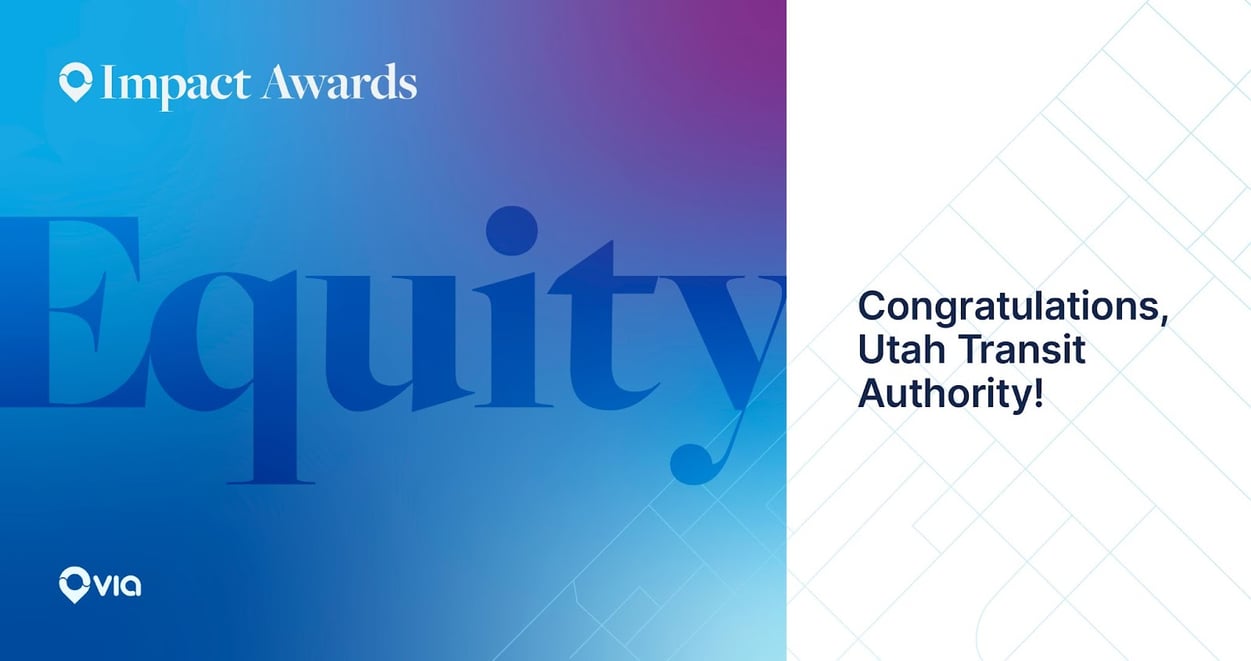In recognition of the Utah Transit Authority’s (UTA) long-standing commitment to accessible, innovative transit, we are excited to announce the agency as a recipient of one of the first annual Via Partner Impact Awards! This year’s inaugural awards focus on equity. UTA has been named “Leader in Equity-focused Innovation” for the agency’s consistent emphasis on delivering the best new mobility technology to riders most in need of accessible, car-free travel options.
Launched in 2019, the microtransit service UTA On Demand offers affordable connections to jobs and transit hubs in southern Salt Lake County. As Utah has experienced record population growth — the fastest in the country at 18.4% from 2010 to 2020 — new transit solutions are ever more necessary to facilitate mobility without depending on expensive and congestion-causing private vehicles. In recognition of the service’s ongoing impact, UTA launched a second on-demand zone in Salt Lake City’s Westside neighborhoods in December 2021.
With low trip costs and connections to TRAX and FrontRunner stations, UTA On Demand has become a critical part of an accessible transit network for residents who can’t or prefer not to drive a car. In a rider survey, more than 90% of respondents said they would be disappointed to lose access to the service. As one rider elaborated, “My disability means I can’t drive. UTA On Demand helps me (and my family) get to school, work, and appointments.”
Getting to know UTA On Demand.
The southern Salt Lake County service zone provides transportation for approximately 190,000 residents in Bluffdale, Draper, Herriman, Riverton, and South Jordan. The Westside zone serves approximately 60,000 residents in Rose Park, Poplar Grove, Glendale, and Fairpark. The service provides convenient transit with low wait times for a diverse ridership, the majority of whom have an annual income of less than $50k and do not own a car.
Increasing access.
With 80% of riders reporting that they used UTA On Demand to commute to work or connect to public transit, it is little surprise that the most common destinations in the southern Salt Lake County zone are transit stops such as the Daybreak Parkway and Draper Town Center TRAX stations, as well as the Draper FrontRunner station.
In the Westside zone, more than 45% of completed trips (in February 2022) began or ended at a transit station: top destinations included Arena station (TRAX Blue and Green lines), 1940 West North Temple station (TRAX Green line), and Salt Lake Central station (FrontRunner). When asked if UTA On Demand expanded access to jobs — as well as education, medical appointments, and social occasions — ~70% of respondents agreed. Additionally, lower-income residents can affordably access 66% more jobs, hospitals, and schools within 30 minutes by public transit than they could prior to the launch of UTA On Demand.
Car-free travel for riders of all abilities.
With ~20% of riders reporting that they have a disability, UTA On Demand is a key service for residents who face barriers to accessing the city’s resources. As one rider described, “I depend on UTA On Demand to get to work and school. It’s essential to my ability to function in my community with my disability.”
Indeed, while nearly 50% of riders reported that without UTA On Demand, they would have made their most recent trip using a less convenient or affordable method — by a private taxi or rideshare service, or by asking a friend for a ride — 12% said that they would not have made the trip at all . While for some riders, the service is one of many options in the connected network envisioned by UTA, for others it is their primary means of accessible transport.
Congratulations, UTA!
We are proud to recognize UTA for its dedication to providing equitable mobility solutions to all of the residents it serves. UTA On Demand has grown from a pilot project to a full-fledged accessible transit network offering enhanced mobility to the ~250,000 residents within its service zones. We continue to look for innovative opportunities to promote equitable transit in partnership with UTA. Congratulations!







